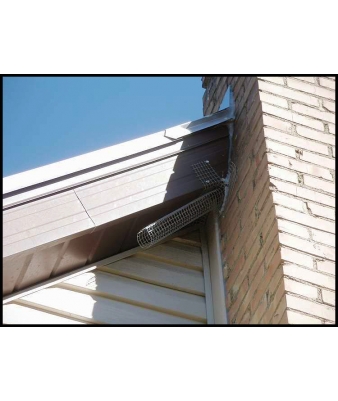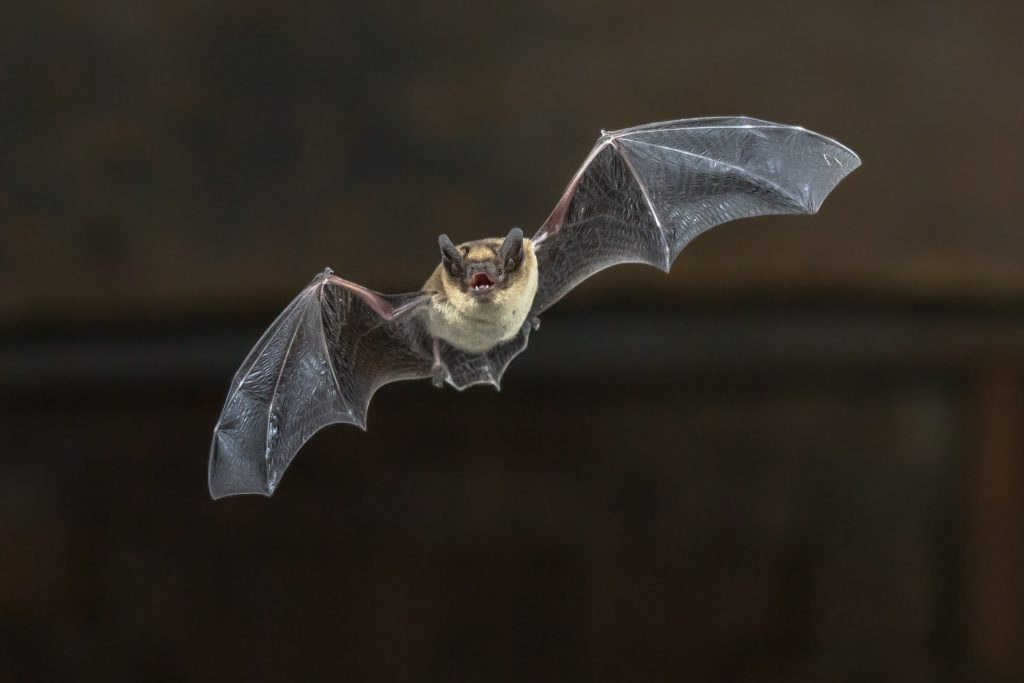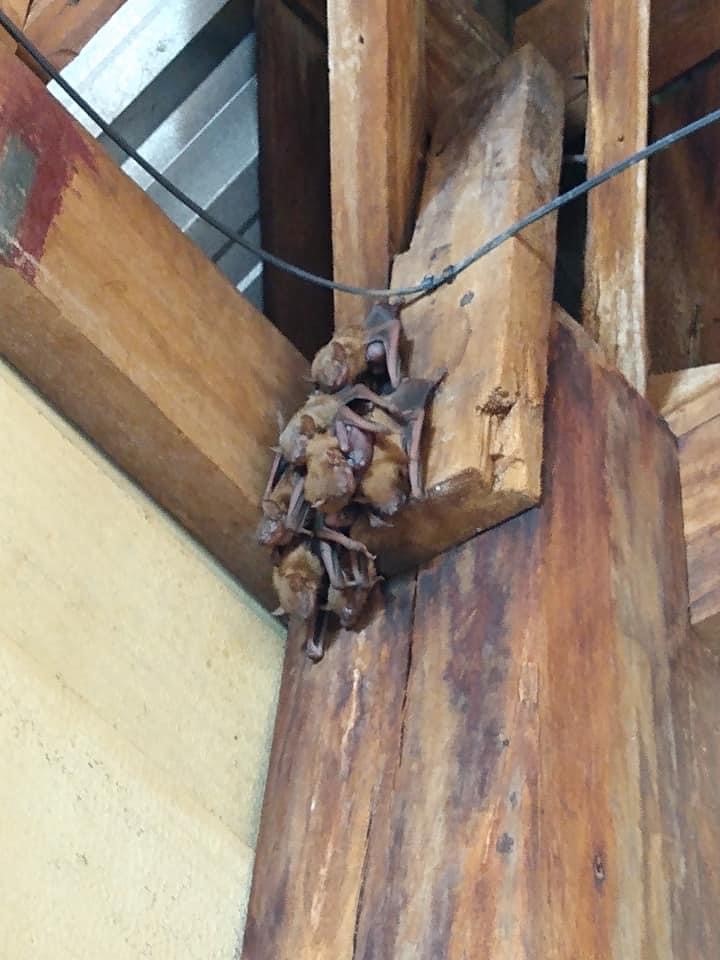Bats are fascinating creatures that contribute significantly to the Canadian ecosystem by aiding in pollination and controlling pesky insect populations.
However, when bats take up residence in homes and buildings, it can become problematic. The accumulation of bat guano from a colony of bats creates a strong odor, weakens the building’s structures, and introduces health risks to people and pets.
Under the Fish and Wildlife Conservation Act, is it illegal to kill bats even if they’ve intruded into your home or attic. Identifying the optimal time for bat removal and eviction is crucial to ensure both the bats’ welfare and the well-being of your home.
Bat species in Canada
The 19 bat species in Canada are all insectivores. Bat activity overlaps insect activity. They will hibernate or migrate during the winter because insects go away when its cold. The breeding season is during the summer when insects are most active.
Depending where you live, the most likely culprits to roost in your attic are the Big Brown Bat, Mexican Free-tail, Little Brown Bat (little brown myotis) and the Yuma myotis.
When is the Best Time of Year to Get Rid of Bats?
The best time of year to implement bat removal is in the late spring before summer and early autumn before it gets too cold.
Bats are a problem when the roost in your attic. Bat roosting happen during the summer and winter. In the winter, bats will hibernate or migrate. Hibernating bats look for warm, humid areas. Natural hibernaculum includes caves, but attics have the ideal conditions for hibernating bats. During the summer, female bats establish maternity colonies to give birth to baby bats. Homeowners cannot disturb hibernating bats or mother bats. Evicting bats during the summer or winter could kill bats.
When is the Best Time of Year for Bat Removal in Vancouver?
Of the 19 bat species in Canada, 15 are confirmed in British Columbia. Of those, the Littler Brown Myotis, Yuma Myotis, and the Big Brown Bat are the most likely to be in your attic. Colonies of Little Brown Myotis and Yuma Myotis can exceed 1000 bats.
The best time to get rid of bats in Vancouver is in the spring from April to June or in the late summer/early autumn, between August to October.
Hibernating Bats in Vancouver
The Big Brown bat is the only bat that hibernates in buildings in Western Canada. They typically hibernate from November through March. There are some rare instances when they wake up thirsty and need water. Installing a one-way door to evict bats at this time will strand them in the cold weather without shelter. Hibernating bats do not have the fat stores or a food supply to survive.
Bat Maternity Season in British Columbia
Female bats are the only bats that roost in attics during the summer. Male bats roost typically roost in hollow trees, cavities, crevices, and under loose bark, primarily in snags.
Female bats create maternity colonies of approximately 40 adult bats. Each female gives birth to one pup. For the first few months, bat pups cannot fly and are totally reliant on their mothers. Excluding female bats at this time will strand the pups in your attic. Once the bat pups can fly, you can humanely apply bat removal techniques.
When is the Best Time of Year for Bat Removal in Toronto?
The eight species of bats that live in Ontario are the little brown myotis, Eastern long-eared, the small-footed bat, the Eastern Pipistrelle, the big brown bat, the silver-haired bat, the red bat, and the hoary bat.
Bat Hibernation in Ontario
Big brown bats colonies vary in size from 12 to more than 200. This species is one of the last to enter underground hibernating sites in fall and awakens first in the spring. It may be seen in flight at dusk in late November and early April, and lives in caves and other natural shelters in colder weather.
Ontario Bat Maternity Season
All the bats roosting in your attic are female. Male bats typically reside in trees and other structures outdoors. A female bat colony is commonly called a maternity colony. These wild animals are using your attic as a safe place to give birth to and raise young bats.
In almost all species of bats, females only have one pup a year. Young bats are unable to fly for several months and are carried by their mothers until they get too big to fly. Most maternity colonies contain about 40 bats, plus their 40 babies.
When is the Best Time for Bat Removal in Toronto?
The best time of year to get rid of bats is between April to May or late August to October.
In the fall, bat pups have grown enough to fly on their own. Maternity colonies have left your attic.
The two most common types of bats that you’ll find are the little brown bat and the big brown bat. These little brown bats and big brown bats typically mate from June through August.
How to Get Rid of Bats
Critter Control specializes in humane bat removal and prevention. It is illegal to kill or trap bats. To avoid breaking any laws or regulations, call a professional for help when dealing with a bat problem.
Our inspector will perform a full interior and exterior inspection. Due to the dangers of exposure to guano, it is extremely important for a respirator to be worn when in an attic containing bats. After inspecting, he/she will construct a custom plan for your home to safely remove the bats and properly seal your home. Our inspector will also provide warranty options as well as educate you on our recurring programs.
If a bat is in your living space at the time of the inspection, the top priority to keep you as well as the bat safe. Bats should never be handled with bare hands. Our wildlife specialist will use gloves specifically designed to handle animals and ensure the bat is safely released outdoors.
Signs of Bats
Identifying the presence of bats roosting in your attic requires vigilance and keen observation. Several telltale signs can indicate their presence.
Firstly, if you notice a strong, pungent odor, resembling ammonia or a musty odor, it could be a sign of accumulated bat droppings, also known as guano. Additionally, if you observe small, dark stains or markings on your walls, ceilings, or near entry points, it may indicate bat activity.
Another common clue is the sound of chirping or squeaking, especially during dusk or dawn, when bats are most active.
Lastly, discovering bat guano or the presence of bat rustling or fluttering noises within your attic can strongly suggest a bat infestation. If you encounter any of these indicators, it is recommended to seek professional assistance to handle the situation safely and effectively.
Critter Control Bat Removal Process
The most effective and humane way to get rid of bats is by utilizing a one way door in conjunction with a full home bat exclusion. A bat valve allows for bats to exit your home but not re-enter.
Since each bat removal is unique, our wildlife control specialist will use or create a bat valve specifically for your home.
We identify all current and potential access points. The eaves of the roof are some of the most common bat entry points. Other potential entry points are gable vents and soffits. Our inspector will determine the proper amount of bat valves to be used, but most bat jobs only require one bat valve.
Once the bat valve is installed, all other bat entry points will be sealed. The bats evict themselves harmlessly. The eviction process typically takes 3-7 days. Our specialist will perform a final attic inspection before removing the valve. After removing the valve, the final entry point will be sealed, leaving your home bat-free.

Bat Exclusion and Habitat Modification
Some bats return to the same roost year after year. If you want to prevent bats from entering your home, preventative bat exclusion is the best precaution you can take. Because bats are not chewers like rodents, they only use existing entry points to make their way into your home.
TIP: Test if gap is a current bat entry point by placing a piece of cardboard over it. If the cardboard has been moved, it is a clear sign of a bat.
Brandon Thorsell, district manager in Toronto
DIY Bat Control at Home
Another way to help prevent bats are to keep outside lights turned off at night. The lights will attract insects, and insects are a huge food source for bats.
Bats also drink a lot of water, so minimizing water sources around your property, if possible, is a way to prevent bats and other wildlife from being a nuisance.
However, with your home excluded, bats are great to have around. Bats will help reduce the insect population around your house, and they also pollinate many flowers and crops that we utilize every day.

